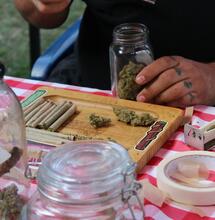Million-Dollar First Weekend of 2022 for Montana

Recreational marijuana products became legal in Montana on New Year's Day. Over the first weekend of legal retail, on Saturday and Sunday (Jan 1 and Jan 2), total expenditure topped $1.5 million. Marijuana products have a 20% tax in Montana, which means sales on the first weekend made the western state richer by $313,000. It's estimated that by the end of the year, the retail of legal recreational marijuana goods will add approximately $130 million to Montana's state budget.
Montana's Department of Revenue said during the first weekend of legal recreational marijuana sales in the state, customers purchased more than $1.5 million in cannabis goods or $1,566,980, to be exact.
Marijuana dispensaries around Montana prepared for months for the big moment. An estimated 380 cannabis shops across 29 counties were eligible to start sales for adult users on New Year's Day. The same shops previously held licenses to serve medical marijuana users. Montana regulators reserve the right to grant permissions to new businesses only after June 2023.
Medical marijuana retail on the first Saturday and Sunday of the year topped $443,000, however, dispensary managers said many medical users stockpiled before the launch of recreational sales.
Medical marijuana products are taxed at 4% in Montana, so the first weekend's sale brought in an additional $17,300 to the state budget, according to Montana's Department of Revenue.
Montana voters approved the recreational use of marijuana in the November 2020 elections. A legislature was passed in 2021, enabling legal retail as of 2022.
Under Montana laws, adults 21 and above can purchase and possess up to an ounce of cannabis, as much as 8 grams of concentrate or edibles infused with no more than 800 mg of THC, the psychedelic cannabinoid extracted from marijuana plants.
The retail of recreational marijuana products in Montana should generate around $130 million for the state budget. According to more estimates, this number will jump to $195 million in 2023.
Recreational retail vs. medical users
Recreational marijuana was made accessible in 29 of the state's 56 counties on New Year's Day. In counties where voters didn't approve adult use of marijuana, a subsequent election may help rekindle the law. The launch of legal retails in Montana brought familiar fears for medical users, however.
When recreational marijuana became legal in other US states in the past, such as in Illinois or Colorado, some dispensaries were forced to shut down operations temporarily or introduce limits on purchases.
Some 55,000 Montanans who hold medical marijuana cards and use cannabis to treat various health conditions may face difficulty supplying their medicines in the months to come.
It can sometimes take more than a year for a new legal market to stabilize. It could take much less than that if trade of cannabis goods across state lines were made legal. Some legal states, such as California, produce more marijuana than the domestic market can actually consume, but cannot export excess produce to territories that face shortages.
Until marijuana remains illegal under federal law, dispensaries that face shortages cannot rely on imports outside state borders. The rule is that a state can only sell what's grown in that state. In any other case, cultivators and vendors can be pressed with federal charges.
It hopefully doesn't come to that, but for now, medical marijuana users in Montana may need to brace for shortages, or be ready to travel longer distances to supply their medicines.

_11zon.jpg)





